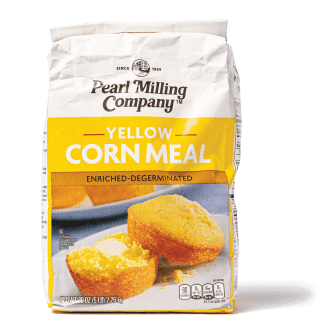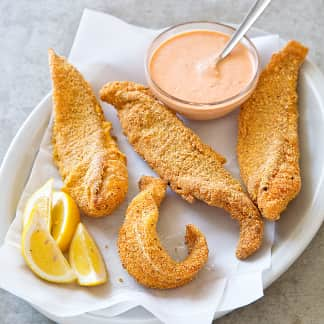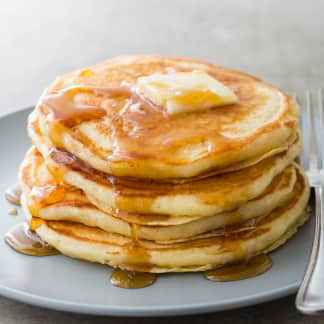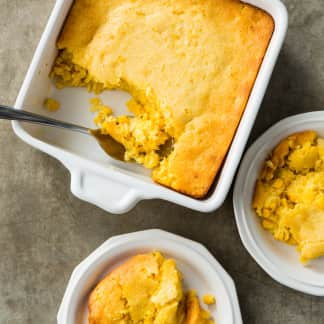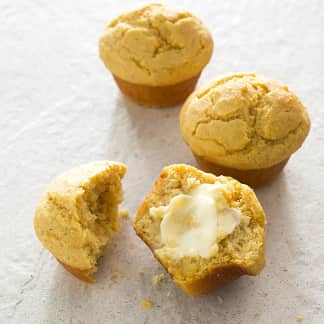I used to take cornmeal for granted. Growing up in Louisiana, cornbread, arguably the most common of cornmeal applications, was often on the dinner table. Sometimes it was even shaped like little ears of corn, courtesy of a molded cast-iron pan. (If you’re ever in an antique store in the South, I highly recommend looking for one.) I never questioned the brand of cornmeal because, frankly, that would have been a really weird thing to do as a kid. But as an adult, with multiple cornmeal options on the market and a specific idea of what cornbread should taste like, I now care very much about what different brands have to offer. As chef, PBS personality, and author Vivian Howard states in her 2016 cookbook, Deep Run Roots, “Your cornbread is a window into your soul.” Forget horoscopes, tell me which cornmeal brand you use.

Choosing The Lineup
We had previously tested cornmeal, but our winner was discontinued. So we chose five nationally available brands, excluding cornbread and corn muffin mixes with added ingredients such as sugar and baking soda. If a brand offered multiple grind sizes, we selected “fine” as that’s our preference for baking. Even though we sometimes add cornmeal to fry batters in recipes such as Fried Green Tomatoes and Homemade Corn Dogs, we wanted to test these cornmeals in recipes in which they took center stage. So we went straight to the holy grail of cornmeal applications, which uses all cornmeal and no additional flour: Southern-Style Skillet Cornbread. To see how the cornmeals performed when combined with flour, we made our Cornmeal Buttermilk Pancakes.

Our Top Rated Cornbread Was Smooth And Cakey
Every cornmeal produced satisfactory pancakes. The cornbreads were much more revealing—especially when it came to their textures, which ranged from smooth, moist, and tender to grainy and crumbly. Our least favorite cornmeal produced a “dry” cornbread that “falls apart very easily,” a drawback to most (but not all) tasters. Another product made “grainy” cornbread; some tasters compared it to eating couscous. Even though that product was labeled “fine grind,” the meal itself looked coarser than the rest.
Our 21-person tasting panel overwhelmingly loved the “smooth,” “very moist” cornbread made with our winning cornmeal, noting that it had a “noticeably more soft” texture that “holds together nicely.”
Why The Textural Differences? There Are Germs In Your Cornbread
To assess the grind sizes of the cornmeals, we sifted them using a series of sieves. One product (appropriately labeled as “fine” grind) was significantly finer than the rest, while another (also labeled as “fine”) was markedly more coarse. The grind sizes of the other three—one labeled “fine” and two that offered no specific grind size on their labels—fell somewhere in-between.

The cornbread made with Bob's Red Mill Fine Grind Cornmeal was coarser and looked more "rustic," while the cornbread made using Anson Mills Antebellum Fine Yellow Cornmeal was smooth, with a cakey texture.
Tasters found the very coarse product’s cornbread “grainy,” “gritty,” and more “rustic” than other samples. But overall, tasters cared more about moisture levels than how rough or fine-textured the breads were; they strongly preferred the two “moist” cornbreads to the three that were perceived as being drier. To learn why some of the cornmeals produced moist cornbreads, we talked to Dr. Charles Hurburgh, professor of agricultural and biosystems engineering at Iowa State University. He explained that a cornbread’s moisture level probably had more to do with whether or not the corn kernels were degerminated prior to grinding than with how finely or coarsely they were ground.
Dr. Hurburgh said it’s standard practice for high-capacity corn grinding mills to remove the germ—the center part of the corn kernel that contains vitamins, enzymes, and corn oil—prior to grinding the corn. There are two reasons for this. First, manufacturers can sell the corn oil they harvest from the germ. Second, the oil in the germ will turn rancid over time, so removing the germ prior to grinding helps to prolong a cornmeal’s shelf life.

According to our science research editor, a cornmeal’s label may report that it contains 0 grams of fat, but that doesn’t mean it contains no fat at all. The amounts are just too small to register when calculating the nutritional information. He also noted that, on average, the fat content of degerminated cornmeal is 1.75 percent, whereas the fat content of non-degerminated cornmeal is almost 4 percent. Even though the difference in fat content between the two is small, it can make a difference: cornmeals made from kernels with their fatty germs intact would be more likely to produce a moist cornbread. Sure enough, our two favorite cornmeal products—the ones that produced moist cornbreads—were not degerminated.
What About Enriched Cornmeal?
Along with “degerminated,” we spotted “enriched” on a few of the cornmeal labels. Hurburgh said the “enriched” labeling typically means that the manufacturers of those cornmeals added back the vitamins that were removed during processing. A few brands we tested were enriched, but this enrichment didn’t affect the flavors or textures of the cornbreads we tasted.
Flavors Mattered, But Not As Much As Textures
We didn’t give tasters any condiments for their cornbread—no butter, no honey, nothing. We did this to ensure consistency across all samples and to keep the tasters focused on the flavors of the cornbreads without any distractions. (We weren’t trying to be cruel, we’re just very methodical.)
Tasters observed that some of the cornbreads were more “subdued” in flavor, while others had a “prominent” corn taste. Our lowest-ranked cornmeal produced a cornbread that had a “very strong” corn flavor, with multiple tasters comparing it to a tortilla chip. Our winner, on the other hand, had a more neutral flavor, with some calling it “buttery.” We asked Dr. Hurburgh what might account for flavor differences, assuming the type of corn used might play a role. He explained that it’s difficult to determine the types of corn used to make cornmeals because most grind mills process commodity corn—a wide mixture of different farmers’ grains. However, some, including the manufacturer of our winning cornmeal, do use only one type of corn, which may impart a specific flavor profile.
The Winner: Anson Mills Antebellum Fine Yellow Cornmeal
The cornbread made with our favorite cornmeal, Anson Mills Antebellum Fine Yellow Cornmeal was smooth and tender, cake-like in consistency with a buttery, but generally subdued, corn flavor. We ordered this cornmeal online, as it’s considered something of a specialty product, but not to worry—we also chose a winning supermarket brand: Goya Fine Yellow Corn Meal. The cornbread made with this meal had a pleasant savory flavor and a melt-in-your mouth texture.
Ultimately, we can recommend every cornmeal we tasted. Which product you choose depends on your preferences. If you happen to like a crumbly cornbread or one with a coarse texture, try one of our lower-ranked, but perfectly acceptable, cornmeals.
- Finely ground
- Produced moist, soft-textured cornbread
- Not degerminated
- Buttery, subtle corn flavor
- Taste in Southern-Style Skillet Cornbread
- Taste in Cornmeal Buttermilk Pancakes
- Sift all cornmeals using a variety of screen sizes in order to examine grind size


